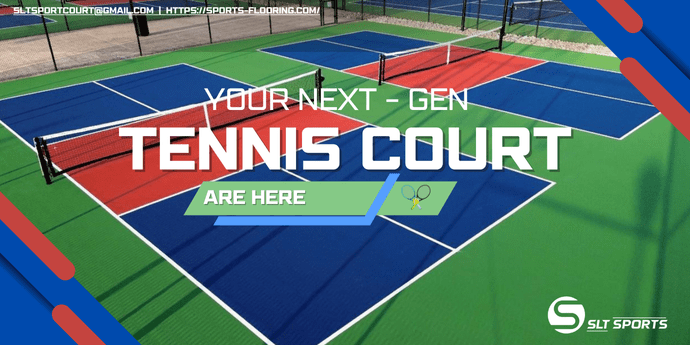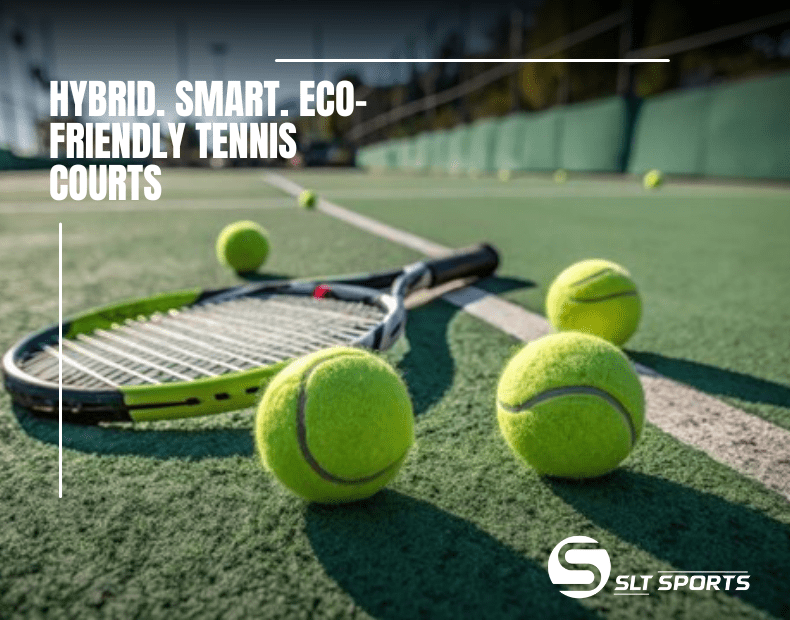
Tennis court trends have changed a lot lately. Tennis courts have seen big changes in their flooring over the past few years. Acrylic surfaces are now the top pick due to their flexibility, toughness, and easy upkeep. These man-made surfaces are built to handle tough weather and lots of use, which makes them a hit with both court owners and players.
The outdoor tennis court flooring scene is changing. Players are moving away from traditional lawn courts to options that last longer. Synthetic tennis courts, acrylic ones, need much less water than clay or grass courts. The cost to resurface tennis courts also drives this change, as managers want to get more for their money over time. On top of that, tennis court synthetic flooring keeps getting better as new tech improves how modern courts look and work.
This piece will look at the newest trends shaping tennis court surfaces down the road. We’ll talk about smart court systems that use sensors and cameras to watch how players move and where the ball goes. We’ll also explore new materials that focus on playing well and being kind to the environment.
Acrylic Tennis Court Flooring Continued Dominance And Evolution
Acrylic flooring still rules the tennis court surface market as a tennis court trends. In India, 99% of courts use this synthetic acrylic material because it lasts long and can handle different weather. New acrylic surfaces have improved a lot. They now have non-slip features but stay smooth enough for play.
Companies have added shock-absorbing layers to newer acrylic surfaces to reduce stress on players’ joints. Also, today’s synthetic acrylic surfaces use pigments that don’t fade, so courts look good for longer. This change allows court owners to keep their courts looking bright and professional without much upkeep.
Rise of Hybrid and Synthetic Flooring Systems
Hybrid surfaces are causing a revolution in tennis court technology. HybridClay has gained ITF 2-star recognition and falls under Category 1 (slow). This ensures top performance while keeping the classic clay court feel. TOP CLAY mixes a synthetic membrane with natural clay filling to create an even uniform court. This stops the holes and cracks you often see in regular clay courts.
ClayTech is another new idea. It combines the sliding of Har-Tru clay with the easy upkeep of hard courts. Unlike normal clay surfaces, these hybrid courts need sweeping now and then and little water. This makes them great for places where water is scarce.
Eco-friendly Alternatives Gaining Traction
Green thinking has led to the creation of eco-friendly tennis court materials. Many new acrylic products now use recycled parts helping wider green goals. For example, rubber from old tires and plastic waste turns into top-notch court surfaces that absorb shocks well.
Non-toxic, water-based coatings have taken the place of harsh chemicals. These new coatings resist UV rays better and give more grip without hurting the environment. Also special paving lets rain soak through instead of running off. This stops flooding near courts and saves water. When fixing up courts, crews reuse old asphalt and stone right there on site. This cuts down on waste and truck emissions a lot.
Sustainability Trends in Tennis Court Construction
Sustainability has an influence on modern tennis court development. Facility owners are realizing that green designs help the environment and save money in the long run.
Water-saving Surface Technologies
Tennis facilities are using new ways to save water that cut down on use a lot. Rainwater harvesting systems (RWHS) can reduce drinking water use by over 50%, which is about what 62 people use in a year. These systems collect water from court covers through gutters and drains that are already there.
For traditional red porous courts, which need 600-900 liters per court each day in summer, two new technologies look promising. Courts built with chemical additives, bentonite, and latex hold moisture better, which cuts down on watering needs. At the same time underground watering systems like HydroCourt keep the right amount of moisture from below using up to 60% less water than regular watering methods.
HydroGrid technology has done away with wasteful watering methods cutting water use in half and reducing surface wear and upkeep costs. These underground systems pay for themselves in 2.5-3 years through ongoing savings.
Low-emission and Recyclable Materials
Courts are now being built with eco-friendly materials more often. For example, PORPLASTIC Tennis comfort pro got the Green Line Eco seal because it gives off very little emissions. This hard court doesn’t have any plasticizers and uses raw materials that look to the future.
These surfaces cost more at first than clay or all-weather courts, but they don’t need watering or sanding between seasons. They’re easy to take care of so the money spent on them is made back . When it’s time to fix them up the top layer needs work, not the whole thing.
Energy-efficient Lighting and Heating systems
LED lighting has a huge impact on tennis facilities. These systems give off brighter light but use less power—leading to cost cuts of up to 50% in some places. Many lights can be dimmed, which saves even more power when you don’t need them at full blast.
Besides saving money, these energy-smart choices help with green goals. Lights that turn on when they sense movement and timers make sure lights are used when needed cutting down on waste when courts are empty. All these smart moves help tennis facilities shrink their carbon footprint by a lot.
Design Breakthroughs For Today’s Game
Tennis courts today are moving away from old-school designs as court owners try to make them work better and look cooler. More than just places to play, today’s tennis court floors are like blank slates for creative ideas and different uses.

Unique Tennis Court Color Choices and Team Logos
The tennis world has moved beyond the traditional green courts. These days, court owners have a wide range of colors to pick from to create eye-catching facilities. Many makers like SLT Sports offer 8 standard tennis court colors trends, which allows for unique mixes that help facilities stand out. During the makeover process, facility owners can choose bold, attention-grabbing color schemes that match team colors, add school branding, or create a distinctive look.
Custom color schemes create unique designs that show off an institution’s traits, like school colors or team identity. Adding logos, mascots, and even motivational quotes on sidelines turns plain courts into branded spaces that boost team spirit and pride. This personalization improves the court’s look while keeping it playable through top-notch paint and sealants.
Multi-sport Court Adaptability
Tennis court flooring has changed to fit multiple sports making facilities more useful and budget-friendly. The big size of a tennis court (78′ x 36′) gives plenty of room to overlay several popular sports layouts. These adaptable surfaces use different colors and line markings to tell sports apart, avoiding mix-ups during play.
Multi-purpose courts can include:
- Tennis + pickleball overlay (fitting 2-4 pickleball courts on a single tennis surface)
- Basketball options (half-court or full-court layouts)
- Badminton and shuffleboard additions
So, this flexibility makes synthetic acrylic surfaces useful, as they support different sports activities without affecting performance.
Better Surface Textures to Grip and Feel Comfortable
Along with looks, tennis court floors now have better surfaces to boost performance. Makers like SLT Sports offer different textures and cushion thicknesses to fit various playing styles. These textured colored coatings give better ball bounce, speed control, and hold up in hot, cold, or wet weather.
New tennis court floors have non-slip surfaces to keep players safe without slowing them down. New synthetic acrylic tennis court materials bend more, which means fewer cracks and better play over time. On top of how well they work, these new surfaces need little upkeep and last a long time. This makes them a smart choice for owners who worry about the cost to resurface tennis courts.
Smart Technology and Automation
Tech is changing our experience of tennis court trends beyond just the playing surface.
Sensor-based Performance Tracking
Advanced sensors now track every part of a player’s game giving new insights. Wearable gadgets work with tennis apps to keep an eye on heart rate, activity levels, and how players move on court. Right now, AI systems like SwingVision look at shots where the ball lands, and how players move, giving feedback right away that changes how people train. Cameras set up around courts grab lots of data, so players can look back at how they did from different angles.
Automated Tennis Court Maintenance Systems
Court maintenance has seen a big change with machines like ROBOTTEN, which takes care of upkeep without needing staff around. You can set these robots to work right away, on a timetable, or when sensors pick something up—they can do jobs from watering courts to putting covers on when it rains. The main things this does are make courts last longer, cut down on how many people you need, and shield surfaces from bad weather.
Conclusion
Tennis court flooring stands at the threshold of a remarkable transformation. Throughout this article, we’ve seen how traditional surfaces have given way to innovative materials that prioritize performance, sustainability, and technology integration. Acrylic surfaces certainly dominate today’s market because of their durability and adaptability, but the future promises even more exciting developments.
Hybrid systems like Hybrid Clay and TOP CLAY represent the next frontier, offering the best qualities of traditional surfaces while eliminating their drawbacks. Meanwhile, eco-friendly alternatives made from recycled components address growing environmental concerns without sacrificing quality.
Sustainability has undoubtedly become central to tennis court construction. Water-saving technologies such as subsurface irrigation systems cut consumption dramatically, while low-emission materials create healthier playing environments. Energy-efficient lighting further reduces environmental impact, making tennis facilities more responsible and cost-effective over time.
Contact SLT Sports Now for synthetic and acrylic tennis court flooring!
Frequently Asked Questions
Recent innovations and trends in tennis court flooring include smart court technologies, hybrid surface materials, and UV-resistant acrylic coatings designed to enhance performance and durability.
Synthetic acrylic surfaces are currently the most sustainable option, requiring less water, fewer chemicals, and offering longer life spans than grass or clay.
Hybrid tennis court surfaces combine the bounce of hard courts with the cushioning of soft courts offering reduced impact on joints while maintaining consistent ball response.
The future-ready tennis court should have ITF-certified surfaces with additional ratings for slip-resistance, UV resistance, and environmental compliance.
Automated irrigation systems, weather-resistant coatings, and data-driven maintenance alerts are making tennis court upkeep more efficient and predictive.

